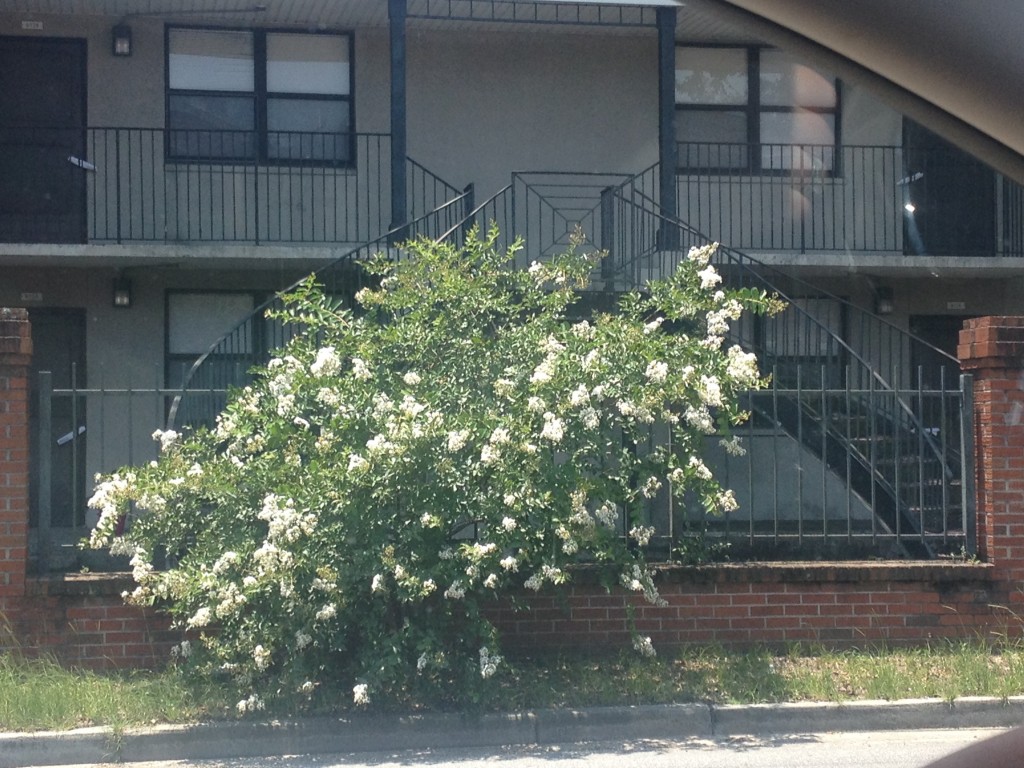Savannah, City of Dreams
Driving down the long, straight expanse of I-95 across South Carolina, our Winterthur caravan passed a billboard advertising Savannah: “The Prettiest Cobbled Streets in America!” An interesting sales tactic, I thought; not what I remembered of the city, but an image that meshed well with my hazy, fifteen year old recollections of massive live oaks, ancient buildings, and dripping Spanish moss. I filed the billboard’s promise away for the next day, when we would explore Savannah for ourselves.
Looking up Abercorn Street in Savannah’s historic district.
But when we reached Savannah’s historic core, under the excellent guidance of David Gobel of the Savannah College of Art and Design, my mental picture simply wasn’t accurate. Live oaks and Spanish moss? Yes, those were there. Grand old buildings? There were plenty of lovely ones, true, but buildings from the late nineteenth or twentieth centuries occupied a significant portion of the streetscape. And the streets …weren’t cobbled. The ones we saw, at least, were all good, durable, twenty-first century concrete. Savannah was a lovely city with a long history writ into the built environment, but it wasn’t the city that its billboards and my memory led me to expect. How had my mental image gone so wrong?
On tour with David Gobel
Savannah’s material fabric is unique in many ways, creating an urban environment that lends itself to an idealizing imagination. Savannah’s city plat, laid out by a board of London governors in 1733, enshrines open space within the city grid. The city was constructed in modular units of a public square ringed with a block of buildings, which, when repeated, guarantees a park every two blocks. Though one square was quickly adapted as a market, the rest, it seems, were intended to be green space on the model of London’s St. James Park.
Savannah City Hall, 1906, built in the best Beaux Arts fashion to replace the City Exchange. Seen from Johnson Square; Savannah’s port was down the bluff just beyond.
Establishing squares was only a part of Savannah’s unique urban environment. The city’s location, on a bluff overlooking the Savannah River, served the double function of keeping the city safe from hurricane flooding and segregating the bustle of port activity, carried out on the riverbank, from the city above. Reinforcing this division, the city’s plan required that two sides of every square be reserved as trust lots for churches and similar public buildings. Though some wealthy citizens managed to secure these trust lots for their mansions, the restriction nevertheless ensured that at least half of the city’s buildings, as viewed from the squares, were grand ones. To see the houses and shops of ordinary citizens, a visitor must peer down the side streets.
Nineteenth century storefronts on the commercial tything lots on Ellis Square, Savannah’s marketplace until the 1950s.
The most notable part of Savannah’s urban environment, however, may be the trees. The massive live oaks and magnolias that fill the city’s squares are a relatively recent addition to the city, planted, for the most part, in a landscaping campaign in the 1890s. Today, however, they are impossible to miss—or, as we found, are impossible to get around when trying to appreciate a building! The trees are venerable, evocative, and important to how we experience Savannah today. But as authentic markers of Savannah’s colonial or antebellum history? On that, the historic record is silent.
Lutheran Church of the Ascension, 1879, on Wright Square. The church does have an (invisible) steeple.
As Epictus is often paraphrased, it is not things themselves that trouble us, but rather, the idea we have of things. In Savannah, the idea I had of the city—that the tourist board worked hard to create, that ten-year-old me half-remembered for the next fifteen years—was simply not borne out by the material reality of the urban fabric. But that same urban fabric, in turn, worked to support Savannah’s romantic image, suggesting a reality that was not there. The live oaks provide a distinctly Southern screen for the city, preventing a casual visitor from seeing buildings completely. It is easy, therefore, to stroll happily among the shaded squares, imagining histories for the half-seen edifices, overlooking, meanwhile, the vastly more complicated and vital reality.
A significant portion of Savannah’s appearance is due to historic preservation, preservation by neglect, and historically minded re-development. These public housing units, just east of the historic center, evoke Savannah’s mansions with their curved double stairways.
Many thanks to David Gobel, whose excellent tour sparked this blog post. All photos and any errors are the author’s.
By Elisabeth Meier, WPAMC Class of 2017







Leave a Reply